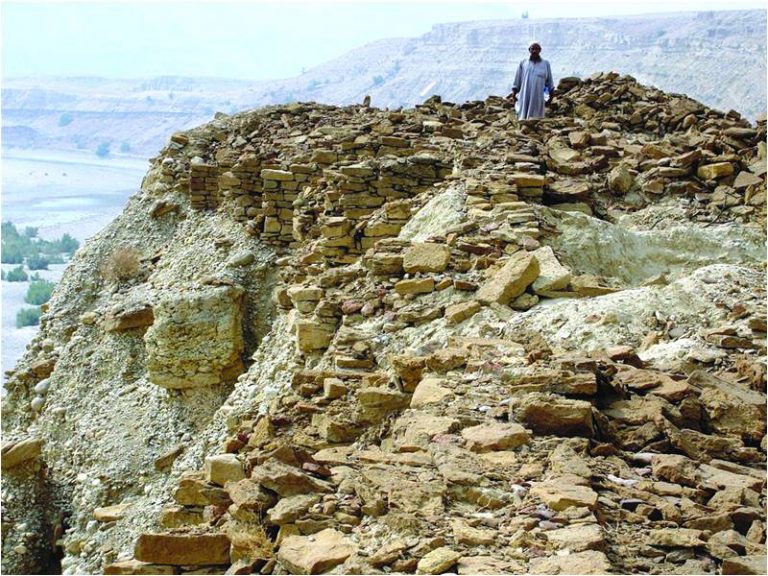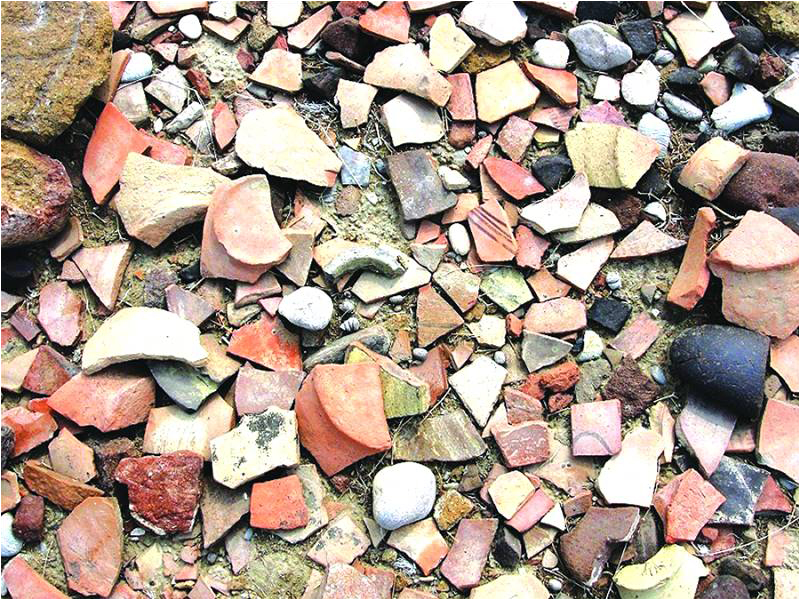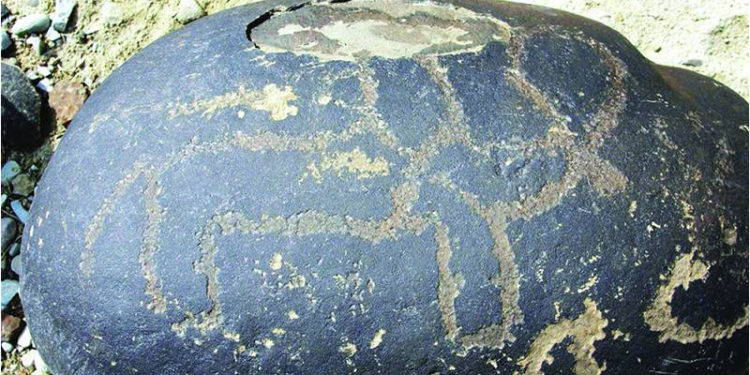
There are also many prehistoric and Indus-period sites in different Nais or valleys in Khirthar. Of these, the Rohel Ji Kund site is quite prominent.
Like many other heritage sites nearby, this site can be a potential tourist destination if the authorities concerned seriously want to promote tourism in Khirthar and its piedmont.
Zulfiqar Ali Kalhoro
The Khirthar mountain range abounds in sites of archaeological and historical significance. In each of its valleys are located rock art sites and other archaeological treasures. There are also many prehistoric and Indus-period sites in different Nais or valleys in Khirthar. Of these, the Rohel Ji Kund site is quite prominent.
At Rohel Ji Kund are found the remains of a settlement of the Amri Phase, a pre-Harappan site in Gaj valley. It is believed that the great explorer of the Kacho, Kohistan and Khirthar areas of Sindh, N. G Majumdar, was killed at this site by bandits during the excavation of the Rohel Ji Kund site.
There are remains of two structures, a fort and a stone circular structure, at the Rohel Ji Kund site. The stone fort is built in a rectangular plan. Small rooms or cells are located inside the fort. The entrance of the fort opens to the north. There were four watch towers as one reconstructs the architecture of the fort from its remains. I have also seen a similar stone fort in the Rustamani Sori Nai which is situated south of Gaj Nai. As one walks northwest of the fort, one can find painted and simple potsherds scattered on the ground. Some potsherds depict pipal leaf and peacock designs. Rohel Ji Kund is remarkable as a settlement predominantly of the Nal culture with unmistakable Amri contacts. Moreover, Rohel Jo Kund is unique among Sindh’s sites so far discovered in showing a large number and rich variety of motifs peculiar to Nal pottery, a number of which have been found for the first time east of Balochistan. Indeed, much of the pottery is so characteristically Nal that it seems reasonable to conclude that there was a settlement of people from later stages of the Nal culture. Probably they were in contact with, or living with, people of Amri culture. Evidence from other sites in Sindh confirms, however, the likelihood that this Nal settlement at Rohel Ji Kund was contemporaneous with the Amri culture. Another significant point from an archaeologist’s point of view is the discovery of Nal and Amrian pottery at Rohel-Ji- Kund on the surface or at very shallow depths.
To the north of the stone fort is situated a stone circular structure. It is three to five feet high from the ground. The outer wall of the structure carries two rows of black boulders, alternating with brown dressed stone rows. Similar black boulders were also used in a structure at Jaro Dan which lies 2 km north of the circular building. This structure is a square in the plan and has four openings reminiscent of a fire temple of the Sassanid period (Char Toq). Close to this structure are the remains of fallen menhirs and a stone circle.

There are some boulders at Rohel Ji Kund which depict a bull, a Bactrian camel, an Ibex, a mountain goat and some birds. These boulders are lying close to the stone circular structure. Some of the boulders were used in this structure. This structure itself, which is perhaps a fire temple, depicts bulls, camels, birds and ibex figures. The main entrance of the structure opens to the east, flanked by two black boulders depicting bull images. Now both boulders are lying close to the entrance. I have never seen such structure elsewhere in Sindh with engraved boulders. However, there are similar structures in different Nais in Khirthar – but without the engravings. A few such structures are also seen in Sindh-Kohistan, particularly in Thano Bula Khan and Taung areas in Jamshoro district.
There are seven boulders with engravings. There are three humped bull images on the boulders of which two has joined legs and the other has separated legs. One of the bulls with joined legs stands before an unidentified object. In between his front and hind legs are two symbols of which one is possibly the fire altar. On the back of the hump of the bull are also some unidentified symbols. The second boulder depicts a bull with curved horns and joined legs. It is shown with belts. One finds hundreds of such bull images in Nali Nai, with belts and joined legs. Three unidentified signs are also on the same boulders which were engraved later. The third boulder depicts a bull with separated legs. A hump, tail and curved horns of the bull are prominent.

One finds many bull images in other rock art sites of Gaj and Nali valleys. At Sado Mazo rock art site, which is about 8 km from Wahi Pandi town, there are 11 bull images of which one has separated legs. All others are engraved with joined legs. Terracotta bull figurines with joined legs are found from the early Indus period. Such terracotta bull figurines are also found from the Ravi/Hakro phase (3700-2800 BC). The Indus seals and pottery from Mohenjo-daro and Harappa depict bulls with separated legs. Several other sites of the Mature Indus period namely Nindowari, Nausharo and Rana Ghandai also depict bull images in similar style.
Two-humped Bactrian camels with joined legs are also engraved on a boulder. The tail, neck and head of the camel are visible. Another boulder shows the figure of mountain goat with a prominent goatee beard. It is depicted with a stylized long tail. One of the boulders shows the hump shaped figure surrounded by hammer markings.
Rohel Ji Kund is the only site in the Gaj valley where there are boulders depicting bull figures. At the other rock art sites, bull figures are engraved on the cliffs locally called “ban”. Apart from bull figures, a bird’s image is also engraved on one of the boulders. The beak, eye and wings and legs of the birds are prominent.
Like many other heritage sites nearby, this site can be a potential tourist destination if the authorities concerned seriously want to promote tourism in Khirthar and its piedmont.
_____________________
 The author is an anthropologist and has authored eleven books including ‘Symbols in Stone: The Rock Art of Sindh’, ‘Perspectives on the art and architecture of Sindh’, ‘Memorial Stones: Tharparkar’ and ‘Archaeology, Religion and Art in Sindh’. He may be contacted at: zulfi04@hotmail.com
The author is an anthropologist and has authored eleven books including ‘Symbols in Stone: The Rock Art of Sindh’, ‘Perspectives on the art and architecture of Sindh’, ‘Memorial Stones: Tharparkar’ and ‘Archaeology, Religion and Art in Sindh’. He may be contacted at: zulfi04@hotmail.com
Courtesy: The Friday Times Lahore